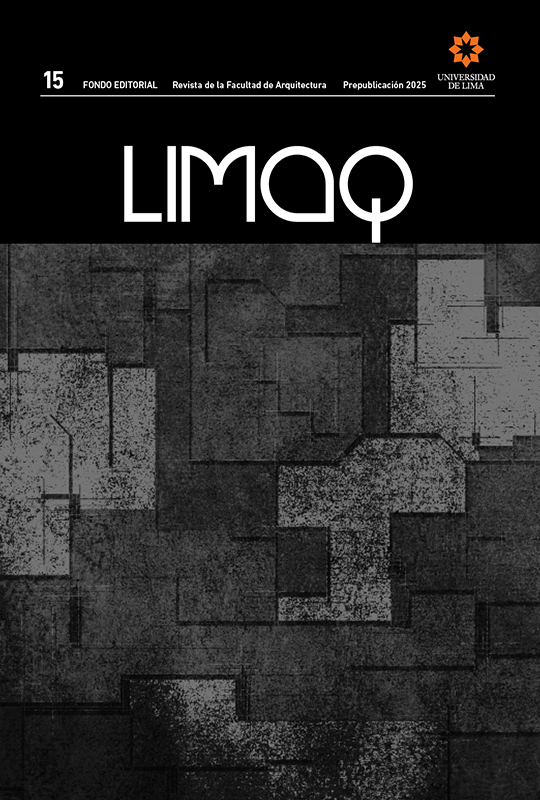Imagined Lima: unbuilt projects in Lima published in the magazine Ciudad y Campo, 1924-1930
DOI:
https://doi.org/10.26439/limaq2025.n015.7187Keywords:
Ciudad y Campo, Lima, Leguia's oncenio, unbuilt projectsAbstract
The magazine Ciudad y Campo was published during the Oncenio de Leguía (1919-1930), between 1924 and 1930. In the 48 issues of the magazine, articles were published that included projects of great architectural and urban planning value that ultimately did not reach be built. The objective of this research is to expose and determine the value of unbuilt projects in a city of Lima that, according to Ciudad y Campo, sought to be the “Capital of the western Pacific coasts”. Likewise, highlight the importance of the content of Ciudad y Campo magazine for the history of architecture in Peru. The proposed methodology is based on the documentary review of the magazine, sample selection and use of data collection techniques of documentary and content analysis. It is a documentary research, of a mixed type and from the data collected they are processed and analyzed by induction and deduction. The results of the research reaffirm the significance of the unbuilt projects published in Ciudad y Campo, and their value as a periodical publication with architecture and urban planning content at the beginning of the 20th century.
Downloads
References
Almandoz, A. (2003). The Emergence of Modern Town Planning in Latin America – after a Historiographic Review. Artikkelit Joulukuu, (1), 1-33.
Arias, J., Landaeta, P. & Candia-Cáceres, A. (2018). Más allá del urbanismo situacionista. Acerca de New Babylon de Constant. Quintana: Revista Do Departamento De Historia Da Arte, (16), 141-156. https://doi.org/10.15304/qui.16.3610
Basadre, J. (2005). Séptimo periodo: el Oncenio (1919-1930). En: Historia de la República del Perú (1822-1933), t. 14. El Comercio.
Benavides Gárate (1928). La Modernización de Lima. Cinco nuevos e importantes edificios. Ciudad y Campo, (41), suplemento 1.
Clark, M. (1930). Reliquias Coloniales de alto valor Arquitectónico. Ciudad y Campo, (47), 26-29.
Clayton, L. (2002). Estados Unidos y el Perú: 1800-1995. Centro Peruano de Estudios Internacionales - CEPEI.
Cuadra, M. (2010). Arquitectura en América Latina: Perú, Bolivia, Ecuador y Chile en los siglos xix y xx. Universidad Nacional de Ingeniería.
Contandriopoulos, C. (2013). Architecture and Utopia in the 21st-Century. Journal of Architectural Education, 67(1), 3–6. https://doi.org/10.1080/10464883.2013.771021
Delgado Galimberti, L. (2008). Contribución teórica en los temas de arquitectura y ciudad tratados en la revista Informaciones y Memorias de la Sociedad de Ingenieros del Perú entre 1899 y 1937 [Tesis de maestría, Universidad Nacional de Ingeniería]. Universidad Nacional de Ingeniería.
Delgado Galimberti, L. (2008). Escritos sobre ciudad y arquitectura en la revista Ciudad y Campo y Caminos 1924-1930. TECNIA, 18(1), 71–87. https://doi.org/10.21754/tecnia.v18i1.364
El Nuevo Mercado para Miraflores (1928). Ciudad y Campo, (40), p. 20.
Gran Casino-Hotel Moderno, Malecón y Bajada en Magdalena del Mar. (1928). Ciudad y Campo, (41), p. 35.
Harth-Terré, E. (1928). Modelos de casas de arquitectura peruana. Ciudad y Campo, (20), p. 20.
La Basílica de Santa Rosa (1925). Ciudad y Campo, (13), 9-11.
La Construcción del nuevo Palacio de Justicia. Los trabajos se comenzarán en breve (1924, julio). Ciudad y Campo, (1), p. 6.
Lange, W. (1926). Estudios del ensanchamiento de Lima. Ciudad y Campo, (19), 37-38.
Ludeña, W. (2002). Lima: poder, centro y centralidad: Del centro nativo al centro neoliberal. EURE, 28(83), 45-65. https://dx.doi.org/10.4067/S0250-71612002008300004
Martuccelli, E. (2006). Lima, capital de la Patria Nueva: el doble Centenario de la Independencia en el Perú. Apuntes: Revista de Estudios sobre Patrimonio Cultural, 19(2), 256-273. https://revistas.javeriana.edu.co/index.php/revApuntesArq/article/view/9036
Millet, N. (2014). El legado de Archigram en la Bartlett. Tres generaciones de arquitectura especulativas: Archigram, Smout Allen y You+Pea [Trabajo final de grado, Universidad Politécnica de Catalunya]. Repositorio Institucional Universidad Politécnica de Catalunya. https://upcommons.upc.edu/handle/2117/352549
Nuestra opinión sobre el nuevo local para la municipalidad. (1924). Ciudad y Campo, (3), p. 38.
OMEGA. (1927, febrero). Los Estudios del Arquitecto Paprocki en Lima. Ciudad y Campo, (26), p. 9-11.
Plano general de Lima, Miraflores, Magdalena, Bellavista, Callao y La Punta (1926). Ciudad y Campo, (23), suplemento 1.
Quispe, F. (2017). La gran Lima y la planificación urbana de 1926. Revista A, (9), 94-99. https://revistas.pucp.edu.pe/index.php/arquitectura/issue/view/1644
Quispe, F. (2020). Urbanizaciones y espacios públicos en Lima: San Isidro, Chorrillos y Miramar. 1919-1930. ARQUITEXTOS, (35), 83-96. https://doi.org/10.31381/arquitextos35.3893
Stiles, T. (1928). Estudios sobre Edificios Penales. Ciudad y Campo, (42), 30-31.
Tepedino, N. (2014). Arquitectura y utopía. Argos, 31(60-61), 121-127. Recuperado en 16 de septiembre de 2024, de http://ve.scielo.org/scielo.php?script=sci_arttext&pid=S0254-16372014000100007&lng=es&tlng=es.
Velarde, H. (1928). La Arquitectura y el Cemento Armado. Ciudad y Campo, (28), 13-16.
Velarde, H. (1930). El Adobe (R.I.P.). Ciudad y Campo, (48), p. 19.



